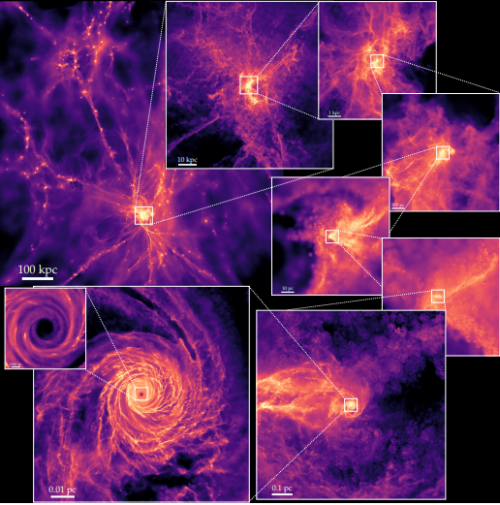2024-07-02 カリフォルニア工科大学(Caltech)
<関連情報>
- https://www.caltech.edu/about/news/cosmic-simulation-reveals-how-black-holes-grow-and-evolve
- https://astro.theoj.org/article/94757-forge-d-in-fire-resolving-the-end-of-star-formation-and-structure-of-agn-accretion-disks-from-cosmological-initial-conditions
宇宙論的初期条件から、星形成の終焉とAGN降着円盤の構造を解き明かす FORGE’d in FIRE: Resolving the End of Star Formation and Structure of AGN Accretion Disks from Cosmological Initial Conditions
Philip F. Hopkins,Michael Y. Grudic,Kung-Yi Su,Sarah Wellons,Daniel Angles-Alcazar,Ulrich P. Steinwandel,David Guszejnov,Norman Murray,Claude-Andre Faucher-Giguere,Eliot Quataert,Dusan Keres
The Open Journal of Astrophysics Published:March 14, 2024
DOI:https://doi.org/10.21105/astro.2309.13115

Abstract
It has recently become possible to zoom-in from cosmological to sub-pc scales in galaxy simulations to follow accretion onto supermassive black holes (SMBHs). However, at some point the approximations used on ISM scales (e.g. optically-thin cooling and stellar-population-integrated star formation [SF] and feedback [FB]) break down. We therefore present the first cosmological radiation-magnetohydrodynamic (RMHD) simulation which self-consistently combines the FIRE physics (relevant on galactic/ISM scales where SF/FB are ensemble-averaged) and STARFORGE physics (relevant on small scales where we track individual (proto)stellar formation and evolution), together with explicit RMHD (including non-ideal MHD and multi-band M1-RHD) which self-consistently treats both optically-thick and thin regimes. This allows us to span scales from ~100 Mpc down to <100 au (~300 Schwarzschild radii) around a SMBH at a time where it accretes as a bright quasar, in a single simulation. We show that accretion rates up to ∼10−100M⊙yr−1 can be sustained into the accretion disk at ≪103schw, with gravitational torques between stars and gas dominating on sub-kpc scales until star formation is shut down on sub-pc scales by a combination of optical depth to cooling and strong magnetic fields. There is an intermediate-scale, flux-frozen disk which is gravitoturbulent and stabilized by magnetic pressure sustaining strong turbulence and inflow with persistent spiral modes. In this paper we focus on how gas gets into the small-scale disk, and how star formation is efficiently suppressed.


